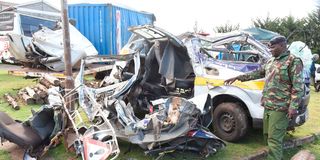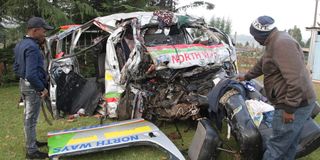Concern as 84 lives lost in a devastating week of road crashes

Timboroa OCS Robert Kitali inspects the wreckage of a 14-seater matatu that was involved in an accident along the Nakuru-Eldoret highway. Five people lost their lives while several were injured on January 5.
Eighty-four people have lost their lives in road accidents in Kenya in the last seven days, according to statistics from the National Transport and Safety Authority (NTSA).
A closer look at the traffic data as of January 7 shows that the number of deaths has increased compared to the same period in 2023.
Between January 1 and 7 last year, 72 people were killed on Kenya's roads.

The 11-seater matatu that was involved in the crash that killed 15 people at Twin Bridge area of Mau Summit along the Nakuru-Eldoret highway on January 09, 2023.
Latest data from the NTSA shows that as of January 7, there were 508 road crash victims, with the majority classified as seriously injured (234), followed by minor injuries (190) and fatalities (84).
Of the 84 fatalities, the majority were pedestrians, followed by motorcyclists, passengers, drivers, pillion passengers and pedal cyclists.
Pedestrians lead the way with 31 fatalities compared to 28 last year, closely followed by motorcyclists with 23 fatalities, a slight decrease from 24 in 2023.
Drivers are in third place with seven having lost their lives in road accidents, compared to six in the same period last year.
Six passengers were killed this year compared to seven in the same period last year, while only one pedal cyclist had died in an accident this year in the period under review.
In its draft National Road Safety Action Plan 2023-2027, the NTSA says a number of national and county government agencies are currently underfunded to deliver safety-related services.
These include the NTSA, the Kenya National Highways Authority (Kenha), the police and county health authorities.
“The annual socioeconomic losses in Kenya as a result of road crashes are estimated to be more than Sh450 billion. There is a need to sustainably finance road safety programmes and cost-effective safety investments in Kenya over the next decade,” says NTSA.
Fatal crashes
According to the NTSA, many accidents occur on the Northern Corridor, which accounts for the high percentage of fatalities.
"Five roads in Nairobi County, representing two per cent of the road network, account for 36 per cent of all fatal crashes in the country," said NTSA Director-General George Njao.
The five roads are: Thika Superhighway, Outering Road, Mombasa-Nairobi Highway, Eastern Bypass and Northern Bypass.
The safety agency says fatal crashes are highly concentrated in time. Twenty-six per cent of crashes in Nairobi (30 per cent of crashes nationally) occur between 7pm and 10pm.
Last year, Transport Cabinet Secretary Kipchumba Murkomen said that drunk driving, speeding, non-use of seat belts and helmets, and unsafe crossing of the road by pedestrians were the main causes of accidents and injuries.
Murkomen also said most accidents, especially in the cities, occurred on Friday evenings and Monday mornings, with a notable correlation to drunk driving.
“We have seen a troubling trend where private vehicles are engaging in serious driving violations, contributing significantly to the alarming accident rates. Unfortunately, these incidents are not only tragic losses but also detrimental to the economy,” he said at the time.
The World Health Organization (WHO) estimates that more than 1.35 million people die on the world's roads each year and up to 50 million suffer non-fatal injuries as a result of road traffic crashes.
They are the leading cause of death for people aged 5-29 years and place an immense socio-economic burden on societies around the world.
In Kenya, as in other low- and middle-income countries, our road safety problem has been driven by a rapid increase in the human and vehicle population, which in turn has led to a rapid increase in traffic.
The overall road system in Kenya cannot cope in its current state, and a very large number of people are killed and seriously injured as a result.
The majority of these people are vulnerable road users: pedestrians, motorcyclists and cyclists. In addition, almost a third of the fatalities are passengers – many of whom die on unsafe public transport.





